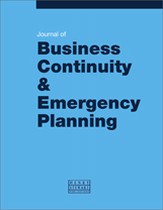Healthcare system resiliency: The case for taking disaster plans further — Part 2
Abstract
For the most part, top management is aware of the costs of healthcare downtime. They recognise that minimising downtime while fulfilling risk management standards, namely, ‘duty of care’ and ‘standard of care’, are among the most difficult challenges they face, especially when coupled with the increasing pressure for continued service availability with the frequency of incidents. Through continuous operational availability and greater resiliency demands a new, combined approach has emerged, which necessitates that the disciplines of: (1) enterprise risk management; (2) emergency response planning; (3) business continuity management including IT disaster recovery; (4) crisis communications be addressed with strategies and techniques designed and integrated into a singular, seamless approach. It is no longer feasible to separate these disciplines. By integrating them as the gateway for service continuity, the organisation can enhance its ability to run as a business by helping to identify risks and prepare for change, prioritise work efforts, flag problems and pinpoint important areas that underpin the overarching business continuity processes. The driver of change in staying ahead of the risk curve, and the entry point of a true resiliency strategy, begins with identifying the synergies of the aforementioned disciplines and integrating each of them to jointly contribute to service continuance.
The full article is available to subscribers to the journal.
Author's Biography
Michael Hiller is the Corporate Business Continuity Manager for Alberta Heath Services. He leads the development and implementation of a province-wide business continuity management (BCM) programme, including education and resource planning. Michael has completed and achieved certification in BCM, disaster recovery, exercising business continuity plans, ICS, business management, and is a standing member of the Education Commission Committee for Disaster Recovery Institute of Canada.
Eric A. Bone is Regional Director of the Office of Emergency Preparedness for Capital Health Edmonton and Area. He came to Capital Health in 2003, having completed 28 years in the Emergency Medical System (EMS) field with British Columbia Ambulance. Eric holds a Diploma in Public Administration from the University of Victoria and a Master of Arts in Leadership and Training from Royal Roads University in Victoria. His certification in emergency preparedness comes from the Justice Institute of British Columbia. He is a member of the International Association of Emergency Managers. Eric has authored and contributed to publications including Canadian Journal of Public Health and Disaster, Mass Casualty, Epidemics/Pandemics, and Terrorism Nursing: Textbook of Medical — Surgical Nursing, and has presented to several national and international conferences.
Michael L. Timmins is an IT disaster recovery specialist at Enbridge Pipelines Inc. He has several years of experience in BCM, emergency management, IT disaster recovery and project management in private, government and healthcare environments. He holds a postgraduate certificate in emergency management and business continuity planning from Sir Sanford Fleming College as well as a bachelor of business administration honours from Trent University. Michael has also successfully challenged the Professional Evaluation and Certification Board’s ‘ISO 22301 Lead Implementer’ exam. He also holds BCM certification from the Disaster Recovery Institute Canada.
Citation
Hiller, Michael, Bone, Eric A. and Timmins, Michael L. (2015, March 1). Healthcare system resiliency: The case for taking disaster plans further — Part 2. In the Journal of Business Continuity & Emergency Planning, Volume 8, Issue 4. https://doi.org/10.69554/SRDK4692.Publications LLP
